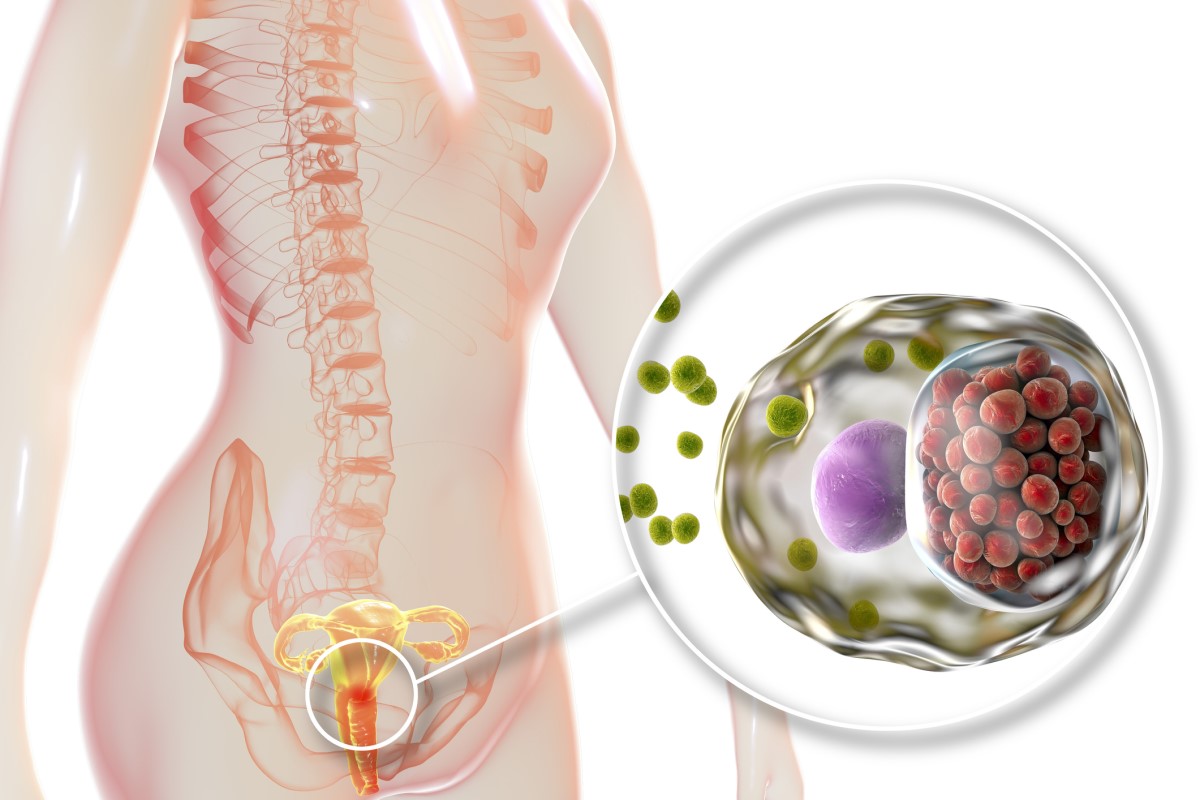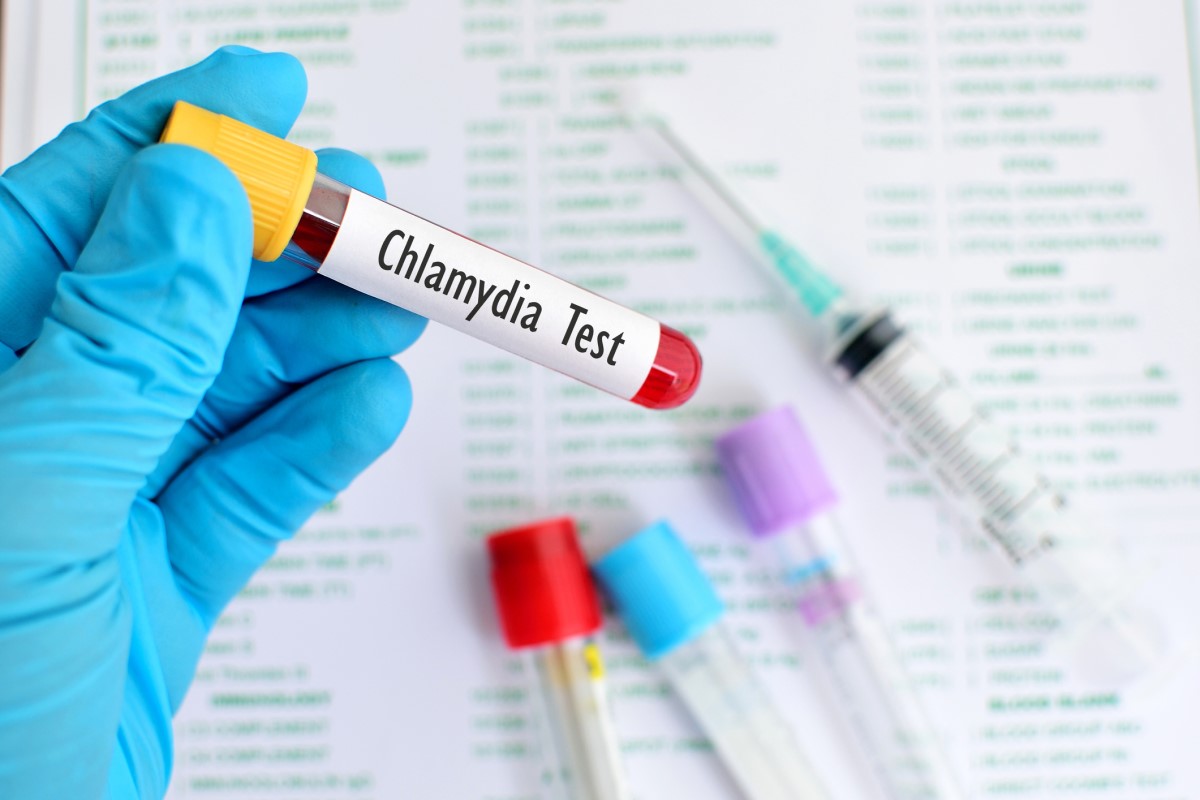- "2015 Sexually Transmitted Diseases Treatment Guidelines". CDC.
- pubmed.ncbi.nlm.nih.gov - Chlamydia cell biology and pathogenesis, Cherilyn Elwell, Kathleen Mirrashidi, Joanne Engel
- ecdc.europa.eu - Chlamydia infection
- who.int – WHO guidelines for the treatment of Chlamydia trachomatis
- cdc.gov - Chlamydia – CDC Fact Sheet
- medlineplus.gov - Chlamydia Infections
Chlamydia Infection: Causes, Symptoms, Treatment

A chlamydia infection is a widespread infection that affects women and men alike. It is caused by bacteria of the genus Chlamydia or Chlamydophila. They cause a wide range of infectious diseases of the genitals, eyes, and respiratory system.
Most common symptoms
- Malaise
- Vaginal Discharge
- Abdominal Pain
- Sore Throat
- Joint Pain
- Urethral pain
- Painful bowel movements
- Lower Abdominal Pain
- Painful urination
- Frequent urination
- Sensitivity to light
- Fever
- Ulcer
- Increased body temperature
- Nausea
- Testicular pain
- Blood in the power
- Bleeding after sexual intercourse
- Smelly discharge from the vagina
- Stool with blood - blood in the stool
- Dry cough
- Itching of the rectum
- Itchy skin
- Itchy eye
- Itching of the vagina
- Fatigue
- Vaginal discharge
- Redness of the conjunctivae
- Reddened penis
- Winterreise
- Enlarged lymph nodes
Characteristics
Chlamydial infections are now a relatively widespread disease, affecting women and men alike, and even certain species of animals.
They are caused by bacteria of the genus Chlamydia or Chlamydophila. Depending on the individual species of this bacteria, they cause a wide range of infectious diseases. In addition to the most commonly genital infections, they are also the causative agents of infections of the eyes and the respiratory system.
Chlamydia are microorganisms (bacteria) commonly found in nature. In terms of structure, they are small gram-negative bacteria that live inside cells. They are called intracellular bacteria.
They attack mucous membranes lined with epithelium (a type of tissue).
They differ from other gram-negative bacteria in the composition of their cell wall. It does not contain muramic acid, but it does contain a greater amount of lipids.
The cells of this bacterium are able to grow and multiply, but they do not have their own enzymatic system for the production of adenosine triphosphate (ATP).
ATP is an organic compound that is a universal source of energy for cells.
Therefore, chlamydiae obtain energy for their own needs from the host cells, which is why they are called intracellular parasites.
Due to their absolute energy dependence on host cells, chlamydiae were considered protozoa and large viruses in the past.
The survival of chlamydiae outside the host organism is relatively short. They survive for 30 minutes in water at temperatures up to 50 °C, and between 1 and 7 days in dead organs.
Their resistance to chemical and physical influences is low. They are sensitive to many disinfectants based on 70% ethanol, formaldehyde, etc. They can be inactivated by moist or dry heat.
Table: Classification of bacteria of the family Chlamydiaceae into genera and species
| Family | Genus | Species |
| Chlamydiaceae | Chlamydia | trachomatis |
| muridarum | ||
| suis | ||
| Chlamydophila | pneumoniae | |
| psittaci | ||
| pecorum | ||
| felis | ||
| abortus |
Table: overview of selected chlamydial species and their effects on the host
| Bacteria | Host | Disease |
| Chlamydia trachomatis | Human | Diseases of the genitourinary tract and eyes |
| Chlamydophila pneumoniae | Human | Pharyngitis, pneumonia, bronchitis |
| Chlamydophila psittaci | Birds, small mammals | Psittacosis - so-called parrot fever, ornithosis |
Chlamydiae cause bacterial infectious diseases of various organs and tissues. Sometimes these diseases are generally referred to as chlamydiosis.
The first bacterium of the Chlamydiaceae family to be discovered was Chlamydia trachomatis (1907).
The most widespread species of chlamydia is Chlamydia trachomatis. It causes genital tract infections, i.e. the most common infections mentioned in the literature in relation to chlamydia.
Genital tract chlamydia infection
Genital chlamydiosis represents one of the most common sexually transmitted diseases. It occurs more frequently than gonorrhoea or syphilis.
It affects both men and women, but the incidence is higher in women. It is more common in young sexually active people, especially in women aged 15-24 years.
Surveys show that the number of chlamydia infections in Europe is steadily increasing.
Approximately 3 million new cases of the disease are added annually.
The main danger of chlamydial infection is that the vast majority of cases are asymptomatic (up to 80% of infections in women and 50% of infections in men are asymptomatic).
An asymptomatic infection delays diagnosis, which can lead to serious health consequences. If the infection is unrecognised at an early stage, the first symptoms are quite serious. Often, if complications are discovered too late, they will be irreversible.
In women, untreated genital chlamydiosis can cause chronic pelvic inflammatory disease, ectopic pregnancy, and infertility.
So, the key factor for the detection of a pre-existing disease is a regular checkup by your GP.
Causes
Genital tract chlamydia infections are caused by a bacterium of the species Chlamydia trachomatis.

The infection is spread through respiratory droplets or direct person-to-person contact.
In most cases, the bacterium is transmitted during unprotected sexual contact with an infected person (vaginal, anal or oral) carrying a sexually transmitted disease.
Women are infected through the cervix, rectum or even the throat.
In men, the infection enters the body through the urethra, rectum or throat.
The most common risk factors for the development and transmission of infection are:
- Unprotected sexual intercourse
- Lower age (< 24 years)
- New sexual partner
- Multiple sexual partners
Apart from sexual contact, the infection can also be transmitted via other routes, e.g. from an infected mother to her baby during childbirth. In very rare cases, transmission has been reported to occur via the mucous membrane of the eye.
Symptoms
As we have already mentioned, genital chlamydial infections are significantly dangerous, especially because a high percentage of infected people do not show any concomitant symptoms of the disease.
We are talking about a so-called asymptomatic, or clinically silent infection.
The absence of symptoms of advanced disease and the associated ignorance of infectiousness causes affected people to spread the infection on to their sexual partners. The fact that symptoms do not appear until later (if at all), several weeks after sexual intercourse with an infected person, also contributes to the spread of the disease.
Symptoms of infection in women
In women who become infected with chlamydia, the primary infection occurs in the uterine cervix, causing cervicitis.
The most common symptoms of inflammation are:
- purulent vaginal discharge,
- sometimes accompanied by bleeding,
- vaginal itching
- and a dull pain in the lower abdomen.

Sometimes, the urethra is infected, which leads to the development of urethritis.
It presents with:
- difficulty passing urine, pain or burning sensation,
- lab test confirming white blood cells or pus in the urine.
Due to the relatively close anatomical proximity of the ureters and vagina, both genital and urinary system inflammation may co-occur.
The infection can travel from the cervix to the higher reproductive organs, i.e. the uterus, fallopian tubes and surrounding tissues, where it causes severe pelvic inflammation, requiring medical intervention.
Symptoms of this inflammation include:
- severe pain and tenderness in the pelvic area,
- fever
- or possibly nausea.
A negative consequence of pelvic inflammatory disease in women is chronic pelvic pain, infertility or ectopic pregnancy.
An inflammation of the fallopian tubes may lead to the formation of a cyst that narrows or obstructs the passageways, which may be a contributing factor to infertility in women.
In cases of direct infection of the rectal area, or if chlamydia spreads from the vaginal to the rectal area, inflammation of the rectum (proctitis) develops.
It presents with:
- urge to defecate,
- pain,
- itching,
- or rectal bleeding with pus.
When infected genital secretions come into contact with the eyes, inflammation of the conjunctiva, i.e. conjunctivitis, may develop with symptoms such as:
- redness,
- swelling,
- itching and irritation of the eyes,
- or light sensitivity.
Chlamydia eye infection is often confused with other, more common eye infections.
In rare cases, when the bacterium comes into contact with the oral cavity or throat, the back of the throat can become inflamed, causing pharyngitis. Symptoms of inflammation are cough, fever and sore throat.

Chlamydia infection in pregnancy
Premature birth can occur in pregnant women with untreated chlamydia infection.
During childbirth, an infected mother can pass the infection to the newborn, which may cause conjunctivitis and pneumonia in the baby. Therefore, a key method of preventing neonatal chlamydia is regular screening and, if required, treatment of chlamydia in pregnant women.
Babies born to mothers infected with chlamydia have up to a 70% chance of becoming infected.
All pregnant women should be screened for chlamydia infection during their first gynaecological examination.
Pregnant women under 25 and pregnant women with an increased risk of developing chlamydial infection (e.g. new sexual partner, multiple sexual partners) should be rescreened in the third semester of pregnancy.
Symptoms of infection in men
A typical consequence of genital chlamydial infection in men is the development of inflammation of the urethra (urethritis). It mainly presents with a mucoid or watery discharge and difficulty passing urin, pain or a burning sensation.
To a lesser extent, the infection can cause inflammation of the epididymis (epididymitis) with symptoms such as pain, tenderness or swelling of the epididymis.
The infection can even spread to the prostate and cause inflammatory complications such as fever, pain during intercourse, and pain in the sacral region of the spine.
As in women, chlamydia infection in men can manifest as rectitis, conjunctivitis or pharyngitis.
Learn more:
Table: the most common symptoms of genital chlamydial infections in women and men
| Most common symptoms in women | Most common symptoms in men |
|
|
Diagnostics
The process of chlamydia diagnosis consists of several steps. At the beginning, the clinical condition of the patient is assessed, it is continued with examinations of microbiological or immunological nature. Finally, the most appropriate treatment is proposed.
Several methods are currently used for diagnosis. They are broadly divided into direct and indirect evidence methods.
Direct evidence is performed directly on the collected cellular material.
Indirect evidence is based on the determination of antibody titres. This is a type of blood test used to detect the presence and level of antibodies in the blood that the body has made in response to an infection.
Indirect evidence methods are never used on their own, they are always only a complement to direct evidence to complete the overall clinical picture.
Swabs for direct evidence are taken from the cervix, urethra, conjunctiva, nasopharynx or rectum. For indirect evidence, blood samples are used.
Table: Methods of direct and indirect evidence of chlamydial infection
| Methods of direct evidence | |
| Direct immuno-fluorescence evidence | A specific antigen on the surface of the bacterium is demonstrated using antibodies. The result is evaluated microscopically. |
| DNA analysis or PCR test | The DNA of the bacterium is analysed. Efficiency exceeds 95-97%. First-choice diagnostic preference |
| Immuno-chromatographic test, so-called Clearview test | Evidence of bacterial antigen. |
| Methods of indirect evidence | |
| ELISA method (enzyme-linked immunosorbent assay) | |
| IMMUNOBLOT kits | |

Course
What is the course a chlamydial infection?
Growth and reproduction of chlamydiae
The developmental cycle of chlamydiae is significantly different from other microorganisms. In their cycle, chlamydiae go through two basic processes.
First, they infect the host cell, then they enter the host cell by phagocytosis. Phagocytosis is the process whereby the bacterium burrows into the cell membrane that coats the bacterium in a vesicle and delivers it to the interior of the cell in this form.
The bacterium enters the cell in the form of a highly infectious elementary body. Elementary bodies have a special coating that protects them from the defence mechanisms of the infected cell, so they can survive once inside the cell.
The specific development cycle of chlamydiae makes them highly resistant to antibiotics.
A few hours after entering the cell, the elementary bodies change into reticulate bodies, i.e. a larger, but no longer infectious form. Their role is very fast cell division, which multiplies the bacteria at a high rate.
After division, the bodies revert to elementary bodies, penetrate into the space outside the cell and invade other host cells. That is how the infection spreads throughout the organism.
During one developmental cycle, up to 10 000 bodies can be formed within a single host cell.
The developmental cycle ends with the disintegration or death of the host cell (direct cell destruction). The whole cycle lasts approximately 48-72 hours and is characteristic of the acute form of chlamydial infection.
Besides the acute form, there is also a chronic form of chlamydial infection where reticulate bodies are transformed into persistent bodies, not elementary bodies.
These bodies are the largest, are unable to divide and survive inside the host cells for an extended period of time, until the next attack of acute infection flares up. They are the cause of the chronicity of the disease.
The body's response to infection
The proliferation of the bacterium and the development of infection will trigger an immune response in the host organism, which activates the cells of the immune system and the production of antibodies.
Antibodies are detectable only after 2-3 weeks after the onset of the disease, which should be taken into account in the diagnosis.
The incubation period, i.e. the time from infection to the appearance of the first symptoms, is approximately 1-3 weeks.
Chlamydiae can significantly modify the course of the host's natural immune response. This is due to their ability to invade the cells of the immune system or their specific form of parasitism in the internal environment of the cells.
The final response of the organism to an ongoing infection therefore depends on the characteristics of the bacterium itself (species, invasiveness, etc.) as well as on the state of the host's immunity.
Chlamydia infection is acute, but the course of the disease is chronic, i.e. long-lasting. After the acute phase, the symptoms usually subside quickly, but if left without treatment, the bacterium will not be eliminated.
The bacterium thus persists in the host cells for several years as a reservoir of microinflammation that can erupt into another acute attack at any time.
Chlamydia infection can also reoccur in people who have had an infection in the past.
Chlamydia pneumoniae
C. pneumoniae most commonly causes upper respiratory tract infections, i.e. pharyngitis (inflammation of the back of the throat) and tonsillitis (inflammation of the tonsils in the upper part of the throat).
Compared to the same inflammation caused by other types of bacteria, such as streptococci, the course of chlamydial infection tends to be milder.
In rarer cases, chlamydia causes sinusitis and otitis.
So-called dual infections are very common, in which chlamydia infection co-occurs with another pathogen.
When the lower respiratory tract is affected, bronchitis occurs, with an acute or chronic course.
A more severe form is lung inflammation, i.e. pneumonia. The course of disease differs from that of pneumonia caused by typical pathogens: longer lasting cough, and shorter, less frequent bouts of fever.
Chlamydia pneumoniae accounts for approximately 6-25% of all cases of pneumonia.
Patients at risk of a worsening of chlamydial infection:
- Geriatric patients.
- Patients with cystic fibrosis.
- Patients with reduced white blood cell count.
- Patients with pre-existing and long-term lung diseases (e.g. asthma).
Chlamydia is spread via person-to-person contact, most commonly as droplet infection.
Diagnosis includes swabbing the upper respiratory tract or, more commonly and more accurately, by mucus evidence. The treatment is the same as the one used for genital chlamydial infections.
C. pneumoniae has also been shown to cause nosocomial infections, i.e. infections arising in hospitalised patients in healthcare facilities.
Conclusion
There is another infectious disease caused by Chlamydophila psittaci:
psittacosis, also called parrot fever, that most commonly affects parrots, but also pigeons or poultry, in which case the disease is called ornithosis.
The infection can be transmitted from birds to humans where it affects the respiratory tract, or the heart, liver or brain in more severe cases.
It is manifested by:
- sudden fever,
- headache and muscle ache,
- sometimes vomiting.
Diagnosis and treatment is based on the aforementioned principles.
How it is treated: Chlamydia Infection
Chlamydia treatment: medication, antibiotics and regimen measures
Show moreChlamydia - You Should Know
Chlamydia Infection is treated by
Interesting resources
Related










